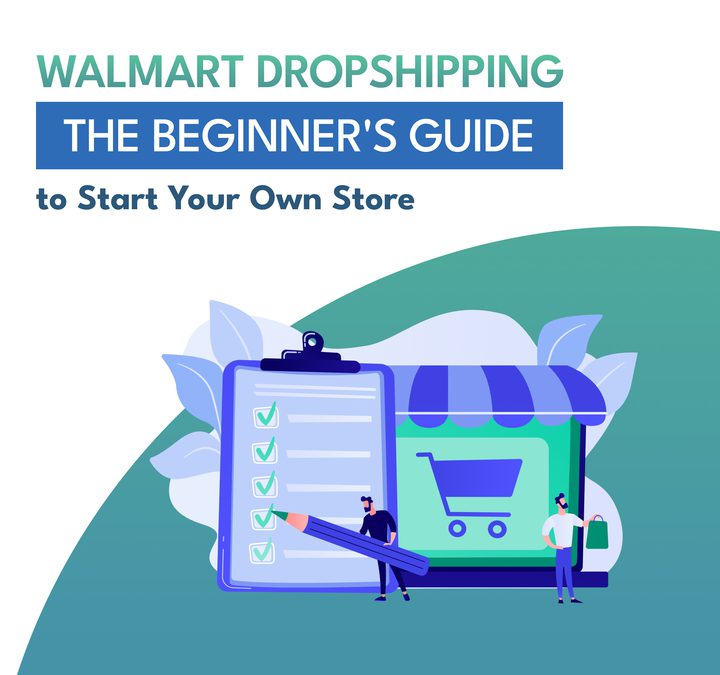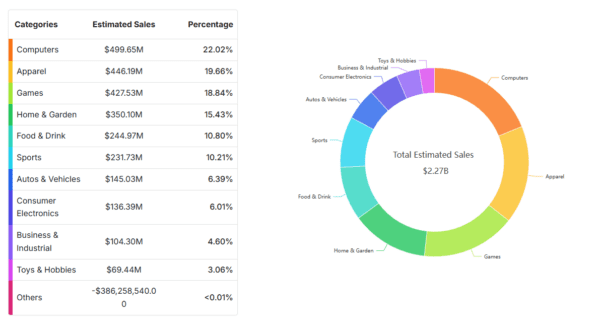
In the ever-expanding world of e-commerce, dropshipping has gained tremendous popularity due to its low start-up costs and minimal risk. Among the various dropshipping platforms available, Walmart has emerged as a prominent player, offering a wide range of products and a trusted brand name. In this comprehensive beginner’s guide, we will explore the world of Walmart dropshipping and provide you with step-by-step instructions on how to start your own store successfully.
Understanding Walmart Dropshipping
Dropshipping is a business model where you, as the store owner, don’t need to keep products in stock. Instead, you work with suppliers who handle inventory and shipping on your behalf. Walmart, being one of the largest retail giants globally, provides an excellent platform for aspiring entrepreneurs to tap into its vast customer base. By leveraging Walmart’s reputation, extensive product selection, and competitive pricing, you can start your dropshipping journey with a strong foundation.
In dropshipping, you act as a middleman between the customer and the supplier. When a customer places an order on your Walmart dropshipping store, you forward the order details to the supplier who then fulfills and ships the products directly to the customer. This eliminates the need for you to handle inventory, packaging, and shipping logistics, making it an attractive business model for beginners.
Walmart offers several advantages for dropshippers. Firstly, it has a wide range of product categories, allowing you to choose a niche that aligns with your interests and target market. Secondly, Walmart has a trusted brand name that instills confidence in customers. Lastly, the competitive pricing on Walmart’s platform gives you the opportunity to offer competitive prices and attract customers.
Getting Started with Walmart Dropshipping
Before diving into the world of Walmart dropshipping, thorough market research is essential. This chapter will guide you through the process of researching market trends, identifying profitable niche products, and conducting competitor analysis. Understanding the demand and competition in your chosen niche is crucial for long-term success.
To start your research, begin by identifying product categories that interest you. Think about your own hobbies, passions, and areas of expertise. This will not only make the process more enjoyable but also enable you to understand your target audience better. Once you have identified potential product categories, use keyword research tools like Google Keyword Planner, SEMrush, or Ahrefs to analyze search volume and competition for relevant keywords.
Additionally, explore online marketplaces, forums, and social media groups related to your niche. Observe discussions, look for popular products or recurring problems that people are seeking solutions for. This will give you insights into the demand and potential opportunities within your niche.
Competitor analysis is crucial for identifying successful dropshipping stores within your niche and understanding their strategies. Take note of their product selection, pricing, shipping times, customer reviews, and overall user experience. This information will help you differentiate your store and offer a unique value proposition.
Once you have identified your niche, the next step is to register as a Walmart Marketplace Seller. We will provide detailed instructions on the registration process, including account setup, verification, and meeting the seller requirements. Being an approved seller on the Walmart Marketplace gives you access to a vast customer base and increases the visibility of your products.
Setting Up Your Walmart Dropshipping Store
To start your own Walmart dropshipping store, you need to choose the right e-commerce platform. This chapter will explore popular platforms like Shopify, WooCommerce, and BigCommerce, and discuss their features, pricing, and ease of integration with Walmart.
Shopify is a widely used e-commerce platform that offers a user-friendly interface and a wide range of customizable themes. It provides seamless integration with the Walmart Marketplace, allowing you to sync your products, inventory, and orders effortlessly.
WooCommerce, on the other hand, is a plugin for WordPress, making it an ideal choice if you prefer to have full control over your website’s design and functionality. With WooCommerce, you can leverage the power of WordPress’s content management system and the flexibility to add various plugins and extensions to enhance your store’s features.
BigCommerce is another popular e-commerce platform known for its scalability and comprehensive built-in features. It offers seamless integration with Walmart and provides advanced marketing and optimization tools to help you grow your business.
Regardless of the platform you choose, ensure that it offers a user-friendly interface, responsive design, secure payment gateways, and reliable customer support. These factors will contribute to a smooth user experience and increase customer trust in your store.
Customizing your store’s design is crucial for creating a unique and appealing brand image. We will provide tips on choosing a visually pleasing theme, optimizing the layout, and creating a seamless user experience. Additionally, we will guide you through the process of integrating Walmart into your store, ensuring smooth product synchronization and order management.
When designing your store, focus on creating a visually appealing and user-friendly interface. Choose a theme that aligns with your brand identity and showcases your products effectively. Pay attention to the layout, navigation, and overall aesthetics to provide a pleasant shopping experience for your customers.
Integrating Walmart into your store involves connecting your store to the Walmart Marketplace and synchronizing your product catalog, inventory, and orders. Most e-commerce platforms offer built-in integrations or plugins that facilitate this process. Follow the platform-specific instructions to set up the integration, ensuring that product details, pricing, and inventory quantities are accurately synchronized between your store and Walmart.
Sourcing Products for Your Walmart Dropshipping Store
Finding reliable suppliers is paramount in dropshipping. In this chapter, we will discuss various methods to find trustworthy suppliers, such as using supplier directories, attending trade shows, and reaching out to manufacturers directly. We will also provide guidance on evaluating supplier performance, including factors like product quality, fulfillment speed, and customer service.
When sourcing products for your Walmart dropshipping store, there are several options available. One of the most common methods is to use supplier directories like Oberlo, SaleHoo, or AliExpress. These directories provide access to thousands of suppliers and products, making it easier to find suitable items for your store. They also often include reviews and ratings for suppliers, allowing you to assess their reliability.
Another option is to attend trade shows and exhibitions in your niche. These events allow you to connect directly with manufacturers and wholesalers, establishing personal relationships and negotiating better deals. Trade shows provide a valuable opportunity to see and touch the products, assess their quality, and discuss potential partnerships.
Reaching out to manufacturers directly can also be a viable option, especially if you have a specific product in mind or want to establish a unique brand. By contacting manufacturers, you can inquire about their dropshipping capabilities, minimum order quantities, and pricing. This approach requires more effort but can result in a more customized product selection and better profit margins.
When evaluating suppliers, consider factors such as product quality, shipping times, customer service, and return policies. Look for suppliers with positive feedback, reliable communication, and a track record of fulfilling orders promptly. Order samples from potential suppliers to assess the product quality firsthand and ensure that it meets your customers’ expectations.
Managing inventory and pricing are crucial aspects of a successful dropshipping business. We will explore inventory management tools and techniques to ensure that your products remain in stock and your customers don’t experience any delays. Additionally, we will provide strategies for setting competitive prices while maintaining healthy profit margins.
Inventory management is critical to ensure that your products are always available to customers. With dropshipping, you rely on suppliers to fulfill orders, so it’s crucial to establish clear communication channels and maintain a good relationship. Use inventory management tools and software to track stock levels, receive notifications when products are low in quantity, and automate reordering processes.
Pricing your products effectively is essential for profitability. Consider factors such as product cost, supplier fees, shipping fees, and desired profit margins when setting your prices. Research your competitors’ pricing strategies to ensure that your prices are competitive while still allowing room for profit. Monitor market trends and adjust your pricing strategy accordingly to stay competitive and maximize sales.
Optimizing Your Walmart Dropshipping Store
To drive organic traffic to your Walmart dropshipping store, you need to optimize it for search engines. This chapter will cover comprehensive keyword research techniques to identify high-demand and low-competition keywords related to your niche. We will guide you on incorporating these keywords strategically into your product titles, descriptions, and meta tags to improve your store’s search engine rankings.
Search engine optimization (SEO) plays a crucial role in improving your store’s visibility in search engine results. By optimizing your store for relevant keywords, you increase the chances of attracting organic traffic and potential customers.
Start by conducting keyword research using tools like Google Keyword Planner, SEMrush, or Ahrefs. Look for keywords that are relevant to your niche, have a high search volume, and low competition. Long-tail keywords are often a good choice, as they are more specific and have less competition.
Incorporate these keywords strategically into your product titles, descriptions, and meta tags. However, it’s important to ensure that your content reads naturally and provides value to the user. Avoid keyword stuffing, as it can harm your rankings and user experience. Instead, focus on creating informative and compelling product descriptions that accurately depict the benefits and features of your products.
Compelling product descriptions play a crucial role in attracting and converting customers. We will provide tips on writing persuasive and informative descriptions that highlight the benefits and features of your products. Additionally, we will emphasize the importance of high-quality product images and videos to enhance the overall shopping experience.
When writing product descriptions, focus on the unique selling points of your products. Highlight the benefits, features, and use cases that make them stand out from the competition. Use descriptive language, storytelling techniques, and bullet points to make the information easily scannable and engaging.
High-quality product images and videos are essential for creating an immersive and trustworthy shopping experience. Invest in professional product photography or use high-resolution images provided by your suppliers. Showcase your products from different angles, highlight key features, and include lifestyle images to help customers visualize using the product.
Fulfilling Orders and Providing Customer Service
Efficient order fulfillment and exceptional customer service are vital for maintaining a positive reputation. This chapter will explore automation tools and software that can streamline the order processing workflow, enabling you to focus on scaling your business. We will also provide guidelines for handling returns, refunds, and exchanges, ensuring customer satisfaction and repeat business.
Order fulfillment is a critical aspect of dropshipping. It involves receiving orders, forwarding them to suppliers, and ensuring that products are delivered to customers promptly. Automating the order fulfillment process can save you time and prevent errors.
Use order management software or integrations provided by your e-commerce platform to automate order processing. These tools automatically forward order details to your suppliers, eliminating the need for manual data entry. They can also sync shipment tracking information, allowing you to provide accurate updates to customers.
Customer service is another essential aspect of running a successful dropshipping store. Promptly respond to customer inquiries and provide assistance throughout the purchasing process. Be proactive in addressing any issues or concerns raised by customers, and strive to resolve them quickly and efficiently.
Offer multiple channels for customer support, such as email, live chat, and social media. Respond to customer queries in a professional and friendly manner, providing accurate and helpful information. Consider using chatbot software to handle common inquiries and provide instant responses outside of business hours.
Handling returns, refunds, and exchanges is an inevitable part of running an e-commerce business. Establish clear policies and procedures for handling these situations, ensuring that they are fair to both the customer and your business. Communicate these policies transparently on your website to set customer expectations.
Maintaining excellent customer support is crucial for long-term success. We will discuss strategies to provide timely and helpful customer service through multiple channels, including email, live chat, and social media. By addressing customer concerns promptly and professionally, you can build a loyal customer base and gain positive reviews.
Marketing and Promoting Your Walmart Dropshipping Store
To generate traffic and increase sales, effective marketing and promotion strategies are necessary. This chapter will explore various digital marketing techniques, including search engine optimization (SEO), social media marketing, and targeted advertising campaigns.
Search engine optimization is essential for improving your store’s visibility in search engine results pages. We will provide advanced SEO strategies, including on-page optimization, link building, and content marketing, to drive organic traffic to your Walmart dropshipping store.
Start by optimizing your product pages and category pages with relevant keywords. Create high-quality content that provides value to users and encourages them to share and link back to your store. Implementing a blog or resource section on your store can help attract organic traffic and establish your store as an authority in your niche.
Leveraging social media platforms like Facebook, Instagram, and Pinterest can significantly boost your brand’s visibility and engagement. We will discuss effective social media marketing strategies, including content creation, community engagement, influencer partnerships, and running targeted ad campaigns.
Create compelling and shareable content that resonates with your target audience. Use engaging visuals, informative captions, and relevant hashtags to increase your reach and attract followers. Engage with your audience by responding to comments, addressing inquiries, and fostering a sense of community.
Influencer partnerships can be a powerful way to reach a wider audience and build trust. Identify influencers within your niche and collaborate with them to promote your products. This can include sponsored posts, giveaways, or product reviews. Make sure to choose influencers whose audience aligns with your target market for maximum impact.
Running targeted advertising campaigns can help you reach potential customers who may not be aware of your store. Platforms like Google Ads, Facebook Ads, and Instagram Ads offer powerful targeting options to ensure that your ads reach the right audience. Experiment with different ad formats, creatives, and targeting strategies to find what works best for your store.
Analyzing Performance and Scaling Your Store
To ensure the growth and profitability of your Walmart dropshipping business, analyzing your store’s performance is crucial. This chapter will guide you on tracking sales and analytics using tools like Google Analytics, Facebook Pixel, and dashboard integrations offered by e-commerce platforms.
Analyzing conversion rates, bounce rates, and customer behavior on your website will help you identify areas for improvement and optimize your store’s performance. We will explore strategies for A/B testing, optimizing product pages, and implementing conversion rate optimization techniques.
Track key performance metrics using tools like Google Analytics, which provide valuable insights into your store’s traffic sources, conversion rates, and customer behavior. Install Facebook Pixel to track the effectiveness of your Facebook ads and retarget users who have shown interest in your products.
Use A/B testing to experiment with different layouts, product descriptions, and call-to-action buttons. Test one variable at a time and analyze the results to make data-driven decisions. Implement conversion rate optimization techniques, such as reducing page load times, simplifying checkout processes, and offering multiple payment options, to improve your store’s conversion rates.
As your store grows, consider expanding your product range, exploring new niches, or targeting international markets. Continuously analyze market trends and customer preferences to identify opportunities for growth. Build strong relationships with suppliers and explore partnerships to expand your product selection and increase profit margins.
Concluding thoughts
Starting a Walmart dropshipping store can be a rewarding venture, offering the opportunity to tap into a vast customer base and leverage the reputation of a trusted retail giant. By following the steps outlined in this comprehensive beginner’s guide, you can set up your own store and navigate the world of dropshipping with confidence.
Remember that success in dropshipping requires continuous learning, adaptability, and dedication. Stay updated with market trends, embrace new marketing strategies, and consistently evaluate and optimize your store’s performance. With perseverance and the right approach, your Walmart dropshipping store has the potential to become a thriving online business.
So, take the first step, research your niche, set up your store, source reliable suppliers, optimize for search engines, provide exceptional customer service, and market your products effectively. The possibilities are endless, and with the right mindset and strategies, your Walmart dropshipping store can soar to new heights in the competitive e-commerce landscape. Good luck on your dropshipping journey!











![35 Trending Products to Sell on E‑Commerce Platforms [2025 Updated]](https://sellerchamp.com/wp-content/uploads/2025/06/image3-3-600x315.png)






